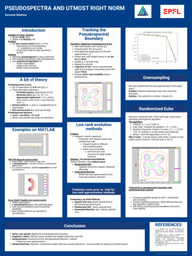pseudospectra and utmost right norm report
This report focuses on how disturbances can dramatically affect the behavior of systems described by matrices, especially when the matrices are non-normal (their eigenvectors are not orthogonal). Normally, the long-term stability of a system is judged by its eigenvalues, but in non-normal cases, eigenvalues can shift a lot under tiny perturbations, making predictions unreliable. To handle this, the study uses pseudospectra, which show where eigenvalues of slightly perturbed matrices might lie, and focuses on the “utmost right” point of the pseudospectrum since this determines the worst-case growth rate of the system. A key algorithm (the Guglielmi–Lubich method) tracks how eigenvalues move under controlled perturbations, but it becomes computationally heavy for large systems. To address this, the project applies randomized low-rank techniques (like randomized SVD and the Nyström method) that approximate matrix behavior more cheaply while preserving accuracy. Finally, it introduces a randomized Euler method that combines these ideas, giving a faster, rank-preserving way to find the pseudospectra boundaries in large-scale problems.

Please sign in
If you are a registered user on Laidlaw Scholars Network, please sign in